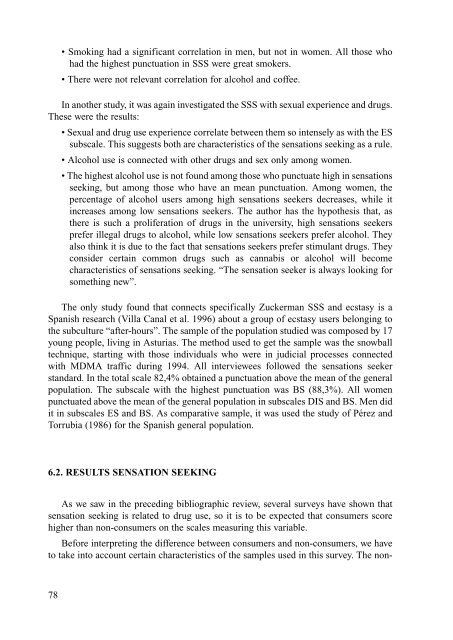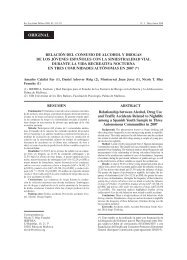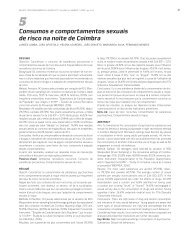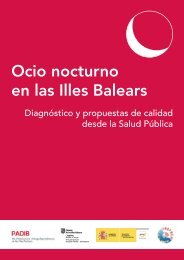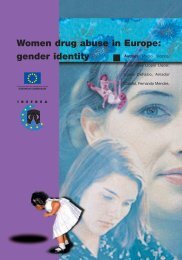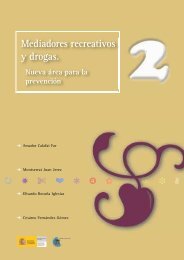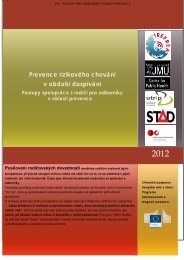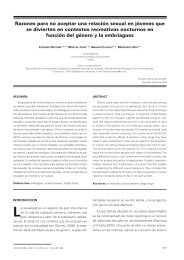Characteristics and social representation of ecstasy in Europe - Irefrea
Characteristics and social representation of ecstasy in Europe - Irefrea
Characteristics and social representation of ecstasy in Europe - Irefrea
Create successful ePaper yourself
Turn your PDF publications into a flip-book with our unique Google optimized e-Paper software.
• Smok<strong>in</strong>g had a significant correlation <strong>in</strong> men, but not <strong>in</strong> women. All those whohad the highest punctuation <strong>in</strong> SSS were great smokers.• There were not relevant correlation for alcohol <strong>and</strong> c<strong>of</strong>fee.In another study, it was aga<strong>in</strong> <strong>in</strong>vestigated the SSS with sexual experience <strong>and</strong> drugs.These were the results:• Sexual <strong>and</strong> drug use experience correlate between them so <strong>in</strong>tensely as with the ESsubscale. This suggests both are characteristics <strong>of</strong> the sensations seek<strong>in</strong>g as a rule.• Alcohol use is connected with other drugs <strong>and</strong> sex only among women.• The highest alcohol use is not found among those who punctuate high <strong>in</strong> sensationsseek<strong>in</strong>g, but among those who have an mean punctuation. Among women, thepercentage <strong>of</strong> alcohol users among high sensations seekers decreases, while it<strong>in</strong>creases among low sensations seekers. The author has the hypothesis that, asthere is such a proliferation <strong>of</strong> drugs <strong>in</strong> the university, high sensations seekersprefer illegal drugs to alcohol, while low sensations seekers prefer alcohol. Theyalso th<strong>in</strong>k it is due to the fact that sensations seekers prefer stimulant drugs. Theyconsider certa<strong>in</strong> common drugs such as cannabis or alcohol will becomecharacteristics <strong>of</strong> sensations seek<strong>in</strong>g. “The sensation seeker is always look<strong>in</strong>g forsometh<strong>in</strong>g new”.The only study found that connects specifically Zuckerman SSS <strong>and</strong> <strong>ecstasy</strong> is aSpanish research (Villa Canal et al. 1996) about a group <strong>of</strong> <strong>ecstasy</strong> users belong<strong>in</strong>g tothe subculture “after-hours”. The sample <strong>of</strong> the population studied was composed by 17young people, liv<strong>in</strong>g <strong>in</strong> Asturias. The method used to get the sample was the snowballtechnique, start<strong>in</strong>g with those <strong>in</strong>dividuals who were <strong>in</strong> judicial processes connectedwith MDMA traffic dur<strong>in</strong>g 1994. All <strong>in</strong>terviewees followed the sensations seekerst<strong>and</strong>ard. In the total scale 82,4% obta<strong>in</strong>ed a punctuation above the mean <strong>of</strong> the generalpopulation. The subscale with the highest punctuation was BS (88,3%). All womenpunctuated above the mean <strong>of</strong> the general population <strong>in</strong> subscales DIS <strong>and</strong> BS. Men didit <strong>in</strong> subscales ES <strong>and</strong> BS. As comparative sample, it was used the study <strong>of</strong> Pérez <strong>and</strong>Torrubia (1986) for the Spanish general population.6.2. RESULTS SENSATION SEEKINGAs we saw <strong>in</strong> the preced<strong>in</strong>g bibliographic review, several surveys have shown thatsensation seek<strong>in</strong>g is related to drug use, so it is to be expected that consumers scorehigher than non-consumers on the scales measur<strong>in</strong>g this variable.Before <strong>in</strong>terpret<strong>in</strong>g the difference between consumers <strong>and</strong> non-consumers, we haveto take <strong>in</strong>to account certa<strong>in</strong> characteristics <strong>of</strong> the samples used <strong>in</strong> this survey. The non-78


